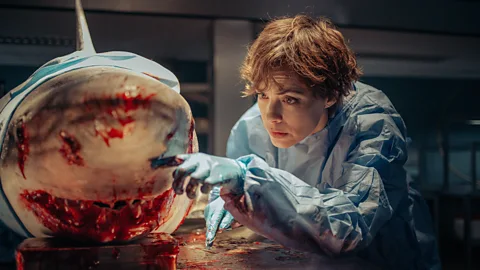 Netflix
NetflixNetflix’s monster movie meets eco thriller set in the French capital is creating serious waves. After the success of Godzilla Minus One, it’s the latest low-budget non-English language film to show the big US studios how popular entertainment is done.
Never mind Emily in Paris, Netflix viewers are currently gripped by Lilith in Paris – Lilith being the name of a man-eating mutant shark. In Under Paris, she can be seen swimming through the Seine, gobbling up anyone foolish enough to go for a dip in the river, and the idea has proven so irresistible that Under Paris is currently the number one film on Netflix. In a summer when Hollywood is struggling to attract audiences to The Fall Guy, Furiosa and its other high-profile releases, perhaps US studio executives could learn a thing or two from the French.
After all, this isn’t the first time in recent months that a smaller film that isn’t in English has shown Hollywood how it’s done. Last year, a Japanese film, Godzilla Minus One, was made at a fraction of the cost of a typical blockbuster, but was rightly acclaimed as the monster movie of 2023, and went on to win an Academy Award for its visual effects. As Caryn James said in her BBC Culture article, its stripped-down yet powerful story appealed to viewers who were tired of Marvel and DC’s over-complicated shared universes, and who wanted “entertainment, not homework”. It also hit Netflix last weekend, and was the platform’s number one film until it was dethroned by Under Paris.
Potential viewers should be warned that Under Paris isn’t up to the 30 storeys-high standards of Godzilla Minus One. It’s a pulpy B-movie whose cut-price effects and camerawork seem more suited to a TV screen than a cinema, and Lilith herself isn’t much more convincing than the holographic shark that snaps at Marty McFly in Back to the Future Part III. Still, when you’ve got the bridges and boulevards of Paris as a backdrop, your visuals are already one-up on those in most films. And the director, Xavier Gens, appreciates the importance of a startling image, however cheaply it’s rendered: blood bursting from someone’s ear as they are dragged down into the high-pressure depths off the sea; a diver’s red flare illuminating a shoal of sharks as it glides above his head. He is also careful to preserve Lilith’s mystique by keeping her off screen for most of the running time, and when she does swim into view she is often depicted as a shadow in the murky waters.
Besides, just as some sharks have to keep swimming to stay alive, Gens’s film is a lean and mean eco-thriller that doesn’t pause to take a breath. Bérénice Bejo from The Artist is admirably straight-faced as Sophia, an oceanographer who attaches tracking devices to sharks so that she can demonstrate how they have been affected by pollution. One shark is affected more than others: in the pre-title sequence, her team visits the North Atlantic garbage patch and sees that Lilith has grown from 2.5m to 7m in just a few months. Three years later, the shark is spotted in the Seine, an event which requires the breathless Bejo to say things like, “That’s impossible,” and, “That’s not normal behaviour,” before Sophia concludes that Lilith has adapted to its fresh water habitat.
 Netflix
NetflixShe decides to hunt down this beast with the help of Adil (Nassim Lyes), a tough river policeman. But a group of environmentalists sees the shark as a symbol of humanity’s mistreatment of the oceans, and so the film, as shallow as it is, already has more depth than The Fall Guy or Godzilla x Kong: The New Empire. A further political dimension comes from Paris’s smug Mayor (Anne Marivin), who would rather keep the matter quiet. The world’s press will soon be gathering for a triathlon which will prove that Paris is ready to host the Olympics, and she doesn’t want any apex predator-related rumours to spoil the fun.
The inclusion of the triathlon is a stroke of plotting genius. As soon as it’s mentioned, the viewer knows that Under Paris will conclude with dozens of men swimming down a shark-infested river in front of crowds of spectators. Some viewers will also smile at the introduction of a mayor who cares more about publicity than public safety, as she is a sure sign that Under Paris, like Godzilla Minus One, was heavily influenced by Steven Spielberg’s 1975 smash Jaws. The highest grossing film ever made until Star Wars came along, Jaws is sometimes cited as the first modern summer blockbuster, but today, almost 50 years later, it seems to belong to a long-gone era when Hollywood’s successes weren’t dependent on comic-book characters and colossally expensive effects.
So maybe US studio executives don’t need to learn from their counterparts in France and Japan. Maybe they just need to learn from their own history. If they can remember how to prioritise concepts over digital images, streamlined plots over elaborate mythologies, and committed actors over complacent superstars, then maybe they’ll have hits as big as Jaws again. As Lilith could tell them, you have to adapt to survive.


